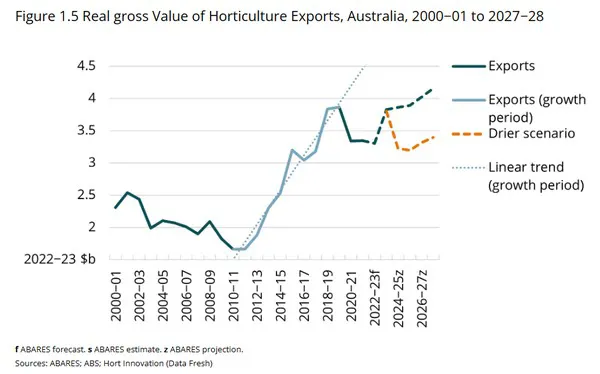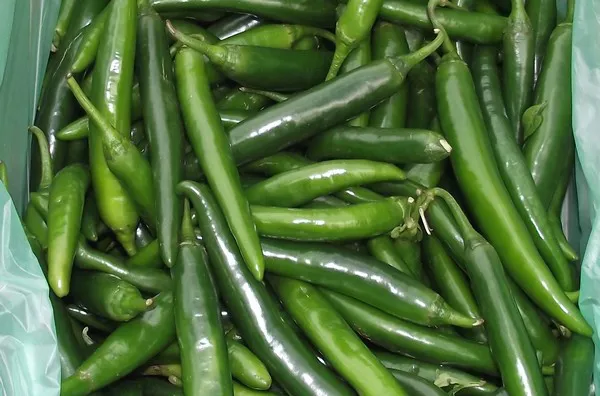The Australian horticulture sector is forecast to continue to reach record-breaking values in the short-term future, on the back of three consecutive years of "exceptional" growing conditions, according to new data released by the Federal Government.
The 2022-23 ABARES Outlook, released today, predicted that in this financial year, the gross value of horticultural production is forecast to reach a record $16.3 billion in nominal terms, and that is expected to rise a further 12 percent to a new record of $18.2 billion in 2023-24.
"Some states have produced their biggest winter crops on record, and these results have provided a huge boost to our farmers and our agriculture industry as a whole," Minister for Agriculture, Fisheries and Forestry Murray Watt said. "The rain this season has been a tale of two extremes, with the heavy rainfall causing some crops to thrive while wiping others out. I know the rains have been incredibly difficult for many flood-impacted communities, including farmers who are still rebuilding, and our Government continues to stand with those communities. For those experiencing prime conditions, record levels of production, driven by exceptional growing conditions and high commodity prices, will put them in good stead to prepare for the future."
The report found that while the cost of fuel, freight, and fertilizer prices have remained a burden for producers, along with the regional flooding in certain parts of Australia, high water storage levels and low water allocation prices have aided in boosting production volumes by easing some of the cost pressures. Furthermore, water allocation prices are forecast to remain low as most dams in the eastern states are at or near full holding capacity, and labor shortages are also expected to continue to ease, supporting the production of fresh produce to remain at high levels overall.
The value of horticulture exports is forecast to rise 21 percent to a new record of $4 billion in 2023−24, according to ABARES. It is expected that improvements in access to labor, low water prices, improved logistics, and less volatile weather in Australia will allow producers to grow more premium-grade produce with fewer quality downgrades than in recent years.
 Source: ABARES Agricultural Commodities Report 2022-23
Source: ABARES Agricultural Commodities Report 2022-23
The outlook also stated, with the ending of La Nina in 2023, it is expected that flooding events will be minimal, which will reduce supply chain disruptions that have driven up the prices of fruit and vegetables. So, while domestic prices for horticultural products are expected to continue to remain elevated, possibly through 2023−24, expansions to fruit and nut crops, along with lower water prices and fewer supply chain disruptions, will bolster production volumes of irrigated fruit and nuts, therefore easing domestic price rises.
Meanwhile, ABARES revealed the gross value of production for the entire agriculture, fisheries, and forestry sector for 2022-23 is expected to reach $96 billion this financial year.
"Despite the strong forecast, we can't be complacent and need to ensure the sector is as prepared as possible to handle the inevitable dry times that lay ahead," Minister Watt said. "This year, we can expect to see drier seasonal conditions going forward, and we'll also likely see an easing in the record-high commodity prices we've been enjoying for the last few years. Our Government is committed to working with farmers and industry in good times and tough ones too."
The National Farmers' Federation says the record output announced puts the industry's $100 billion by 2030' target within reach but says it was not all smooth sailing.
"We've had an absolute belter," said NFF Vice President David Jochinke said. "It was a hard-won result this year. We had extensive crop losses due to flooding, damaged roads, and a wet harvest that stretched well into the New Year. In the end, though, we've seen a record winter crop and strong prices for crops that have underpinned that headline number. We'll expect that number to bounce around in coming years as things dry out, but it shows our $100 billion by 2030 target is well within reach. This confirms yet again what we've been saying for years: that farming is a sustainable growth engine for Australia. We've added over $30 billion in output in the past five years, making farming one of the most exciting growth stories in an economy that's littered with challenges. This is big news for regional communities, but the benefits extend right into our major cities."

But the NFF is warning that with the outlook for the next 2-3 years suggesting commodity prices and rainfall will ease, the farming industry needs to be thinking about how to respond in these leaner years to issues like record production costs which are already placing pressure on farmers' bottom lines, and safeguarding this growth.
To read the full 2022-23 ABARES Outlook, click here.
